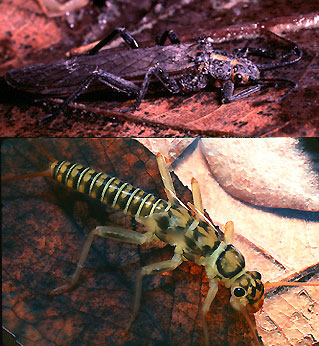Perlodidae
C. Riley Nelson


This tree diagram shows the relationships between several groups of organisms.
The root of the current tree connects the organisms featured in this tree to their containing group and the rest of the Tree of Life. The basal branching point in the tree represents the ancestor of the other groups in the tree. This ancestor diversified over time into several descendent subgroups, which are represented as internal nodes and terminal taxa to the right.

You can click on the root to travel down the Tree of Life all the way to the root of all Life, and you can click on the names of descendent subgroups to travel up the Tree of Life all the way to individual species.
For more information on ToL tree formatting, please see Interpreting the Tree or Classification. To learn more about phylogenetic trees, please visit our Phylogenetic Biology pages.
close boxIntroduction
Perlodidae is one of the largest families of Plecoptera with over 250 species divided between the nearctic, palearctic, and oriental regions. The nymphs are distinctive in often having contrasting patterns of light and dark coloration as well as having gills which are unbranched (or absent). They are predators in the streams where they occur.. They occur in the entire range or lotic environments, from small streams to large rivers.
There has been a tendency to split the genera of Perlodidae such that they contain few species. Monotypic genera abound. Contrast this with the very large genus Isoperla, which may well consist of over 200 species when all species have been described.
Characteristics
Synapomorphies for Peltoperlidae: 1, body stout, head prognathous, cockroach-like nymphal body form; 2, male cercal segments fused; 3, nymphal coxae with flap-like lobe.
Discussion of Phylogenetic Relationships
Different authors have divided up the family Perlodidae into various subfamilies and assigned the genera in a variety of ways. Stark & Szczytko (1984) sorted out these classifications and produced the one given above using characters of adults, nymphs, and eggs.
Classification
The Perlodidae have a high proportion of genera with one or few species. The classification in this list follows that of Stark & Szczytko (1984) and the numbers of species as shown by Zwick (1973) with a few additions, especially in Arcynopterygini (Stark & Szczytko 1988). There have been many additions since Zwick (1973) that have been missed. Please contact Riley Nelson so those additions can be made.
PERLODINAE- Arcynopterygini
- Arcynopteryx, 4 species, Holarctic.
- Frisonia, monotypic, Nearctic.
- Megarcys, 8 species, western Nearctic & eastern Palearctic.
- Neofilchneria, monotypic, Palearctic.
- Oroperla, monotypic, Nearctic.
- Perlinodes, monotypic, P. aureus, Nearctic.
- Pseudomegarcys, monotypic, Palearctic.
- Setvena, 3 species, Nearctic.
- Salmoperla, monotypic, Nearctic.
- Skwala, 3 species, western Nearctic & eastern Palearctic.
- Sopkalia, monotypic, Palearctic.
- Besdolus, monotypic, Palearctic.
- Chernokrilus, 2 species, Nearctic.
- Dictyogenus, 3 species, Palearctic.
- Diura, 3 species, Holarctic.
- Filchneria, 12 species, Palearctic.
- Helopicus, 3 species, Nearctic (C. H. Nelson 1996).
- Hydroperla, 4 species, Nearctic (C. H. Nelson 1996).
- Isogenoides, 9 species, Nearctic.
- Isogenus, 2 species, Palearctic.
- Levanidovia, monotypic, Palearctic.
- Malirekus, 2 species, Nearctic.
- Oconoperla, monotypic, Nearctic.
- Perlodes, 5 species, Palearctic.
- Perlodinella, 4 species, Palearctic.
- Susulus, monotypic, Nearctic.
- Tadamus, 2, species, Palearctic.
- Yugus, 2 species, Nearctic.
- Afroperlodes, monotypic?, Palearctic Africa.
- Baumannella, monotypic, Nearctic.
- Bulgaroperla, monotypic, Palearctic.
- Cultus, 5 species, Nearctic.
- Diploperla, 4 species, Nearctic.
- Hemimelaena, monotypic, Palearctic Africa.
- Kogotus, 2 species, Nearctic.
- Osobenus, monotypic, Nearctic.
- Ostrovus, monotypic?, Palearctic?
- Pictetiella, 2 species, Holarctic.
- Remenus, 3 species, Nearctic.
- Rickera, monotypic, Nearctic.
- Stavsolus, monotypic?, Palearctic?
Perlodini
Diploperlini
- Calliperla, monotypic, Nearctic.
- Cascadoperla, monotypic, Nearctic.
- Clioperla, monotypic, Nearctic.
- Cosumnoperla, monotypic, Nearctic.
- Isoperla, more than 150 species, Holarctic.
References
Nelson, C. H. 1996. Placement of Helopicus rickeri Stark in Hydroperla Frison (Plecoptera: Perlodidae) with the description of the adult female, nymph, and egg and a cladistic analysis of Hydroperla. Proc. Entomol. Soc. Washington 98: 237-244.
Stark, B. P. and S. W. Szczytko. Egg morphology and classification of Perlodinae (Plecoptera: Perlodidae). Ann. Limnol. 20: 99-104.
Zwick, P. 1973. Insecta: Plecoptera. Phylogenetisches System und Katalog. Das Tierreich 94. Walter de Gruyter and Co., Berlin. 465 pp.
About This Page
C. Riley Nelson

Brigham Young University, Provo, Utah, USA
Page copyright © 1996
All Rights Reserved.
Citing this page:
Nelson, C. Riley. 1996. Perlodidae. Version 01 January 1996 (under construction). http://tolweb.org/Perlodidae/13952/1996.01.01 in The Tree of Life Web Project, http://tolweb.org/








 Go to quick links
Go to quick search
Go to navigation for this section of the ToL site
Go to detailed links for the ToL site
Go to quick links
Go to quick search
Go to navigation for this section of the ToL site
Go to detailed links for the ToL site